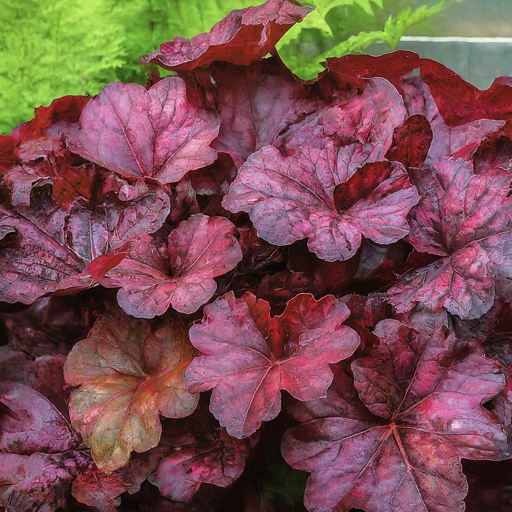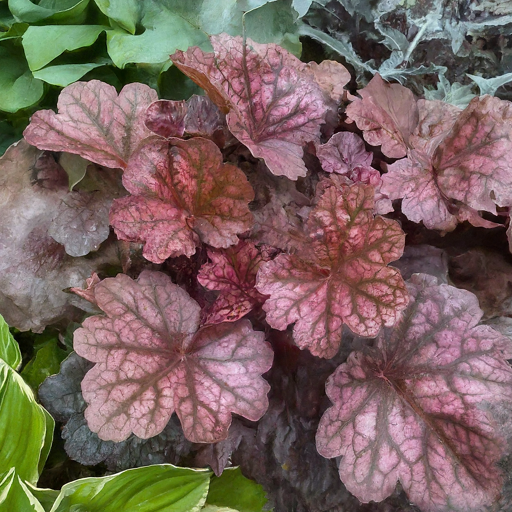
Coral bells, with their dazzling foliage and delicate flower spikes, are a gardener’s delight. But beneath their captivating beauty lies a surprisingly easy-going nature. These versatile plants thrive in a variety of conditions, rewarding you with a season-long display of color with minimal fuss. So, are you ready to add a touch of magic to your garden? Let’s delve into the effortless world of coral bell care and unlock the secrets to vibrant blooms throughout the year.
Finding the Perfect Pitch: Light and Location

The first step to cultivating happy coral bells is choosing the right spot. Unlike temperamental divas, these plants are adaptable to a range of light conditions.
- Sun Worshippers: For varieties boasting fiery red, orange, or chartreuse foliage, a location with 4-6 hours of direct sunlight is ideal. However, keep in mind that afternoon shade might be necessary in scorching climates to prevent scorching of the leaves.
- Shade Seekers: Don’t despair if your garden leans towards the shady side. Many coral bells flourish in dappled sunlight or even partial shade. Varieties with green, silver, or purple hues often thrive in these conditions.
Remember: The key is to find a balance. Too much shade can lead to leggy plants with sparse blooms, while excessive sun exposure can result in wilting and bleached leaves.
Top Tip: Observe your garden throughout the day to determine the natural light patterns. This will help you select the perfect spot for your chosen coral bells variety.
Cultivating a Thriving Oasis: Soil and Planting
Once you’ve identified the ideal location, it’s time to prepare the soil – the foundation of a flourishing coral bells haven.
- Drainage is King: Coral bells despise soggy feet. They require well-draining soil to prevent root rot. If your soil is heavy clay, amend it with compost, coarse sand, or perlite to improve drainage.
- A Feast for the Roots: While coral bells aren’t fussy feeders, rich, organic soil will promote healthy growth and vibrant blooms. Mixing in composted manure or organic matter before planting gives your plants a nutritional head start.
- Planting Pointers: Dig a hole slightly larger than the root ball of your coral bell. Gently loosen the roots before placing the plant in the hole. Ensure the crown (the point where the roots meet the stems) sits slightly above the soil surface. Backfill the hole, tamping down gently to remove air pockets.
- Spacing it Out: Leave adequate space between your coral bells to allow for proper air circulation and future growth. Refer to the specific spacing recommendations for your chosen variety, as it can vary depending on the mature size of the plant.
The Art of Watering: Keeping Your Coral Bells Hydrated
Watering is crucial for maintaining the health and vibrancy of your coral bells. Here’s a helpful guide:
- Consistency is Key: Aim for consistently moist soil, but avoid waterlogging. A good rule of thumb is to water deeply when the top inch of soil feels dry to the touch.
- Frequency Finesse: The frequency of watering will depend on several factors, including weather conditions, sunlight exposure, and plant maturity. Established coral bells can tolerate short periods of drought, while younger plants might require more frequent watering during hot spells.
- Mulch Magic: Applying a layer of organic mulch around your coral bells helps retain moisture in the soil, reducing the need for frequent watering. Bonus points: Mulch also suppresses weeds and regulates soil temperature.
Remember: It’s always better to underwater than to overwater your coral bells. Excess moisture can lead to fungal diseases and root rot.
A Touch of TLC: Feeding, Pruning, and Deadheading
While coral bells are generally low-maintenance, a little TLC goes a long way in maximizing their potential.
- Feeding Frenzy (or Not): Coral bells don’t require heavy feeding. A light application of balanced fertilizer in early spring can give them a springtime boost. Alternatively, a top dressing of compost around the base of the plant can provide sustained nutrition.
- The Pruning Paradox: Pruning isn’t strictly necessary for healthy growth. However, if your coral bells become overgrown or leggy, you can prune them back in early spring. This will encourage bushier growth and promote new blooms.
- Deadheading Delights: To encourage continuous flowering throughout the season, deadhead spent flower stalks. Simply snip off the flower spikes after the blooms have faded. This redirects the plant’s energy towards producing more flowers instead of setting seeds.
Winter Wonderland: Protecting Your Coral Bells
Coral bells are generally cold-hardy, but some protection might be beneficial in colder climates (USDA zones 4-6) or during harsh winters. Here are some tips for keeping your coral bells happy throughout the winter:
- Mulch Marvel: Apply a fresh layer of mulch around the base of the plant in late fall after the ground freezes. This insulates the roots and protects them from fluctuating temperatures.
- Evergreen Allure: Some coral bell varieties retain their foliage throughout winter, adding a touch of evergreen interest to your garden. However, these evergreen leaves might get tattered by harsh winds. You can provide extra protection by covering them with a layer of burlap or frost cloth.
- Spring Cleaning: In early spring, remove any winter protection and gently clear away any dead or damaged leaves. This allows for new growth to emerge freely.
A Festival of Color: Choosing the Perfect Coral Bells Variety
With over 60 species and countless cultivars, coral bells offer a dazzling array of colors and textures to suit any garden style. Here are some popular choices to consider:
- For Sun-Drenched Gardens: Varieties like ‘Georgia Peach’ with its vibrant peachy-orange foliage, ‘Marmalade’ boasting fiery orange leaves, or ‘Lime Rickey’ with its bright chartreuse tones are perfect for sunny spots.
- For Shade Seekers: Coral bells like ‘Obsidian’ with its near-black foliage, ‘Melting Metal’ with its silvery-green shimmer, or ‘Plum Royale’ with its deep burgundy leaves will thrive in dappled shade or partial shade.
- For Compact Charm: Varieties like ‘Mini Mouse’ or ‘Little Cuties’ are perfect for borders or edging, offering a burst of color in smaller spaces.
Remember: When choosing your coral bells, consider the overall light conditions in your garden, desired color scheme, and mature plant size to ensure they thrive in their designated spot.
Beyond the Blooms: The Versatility of Coral Bells
The beauty of coral bells extends beyond their captivating blooms. Their stunning foliage adds a touch of year-round interest to your garden. Here are some creative ways to utilize these versatile plants:
- Border Beauties: Plant coral bells along walkways, borders, or edges of flower beds for a pop of color and textural contrast.
- Container Creations: The compact size of some coral bell varieties makes them ideal for container gardening. Group them with other shade-loving plants for a vibrant patio display.
- Groundcover Gems: Use sprawling coral bell varieties as a low-maintenance groundcover in shady areas. They’ll suppress weeds while adding a touch of elegance.
With their easy-going nature and endless possibilities, coral bells are a true gem for gardeners of all levels. By following these simple care tips, you can cultivate a symphony of blooms in your garden, adding a touch of magic that lasts all season long. So, embrace the effortless beauty of coral bells and watch your garden transform into a vibrant haven.
